How To Choose Between All Those Different Cooking Oils
I was making soup last night – one of those everything leftover in the fridge numbers without a recipe, which this weekend turned out as a lovely, almost brothy-stew with butternut, kale, and fried pieces of chorizo by way of a garnish – and I realised that we keep an excessive amount of different cooking oils in the kitchen, but I do actually use pretty much all of them. But how to choose? How do you know which oil you should use where, or which ones you do actually need when confronted with the intimidating oil aisle in the supermarket? So, I thought instead of posting a recipe or review for you all this morning, I’d break down my collection.
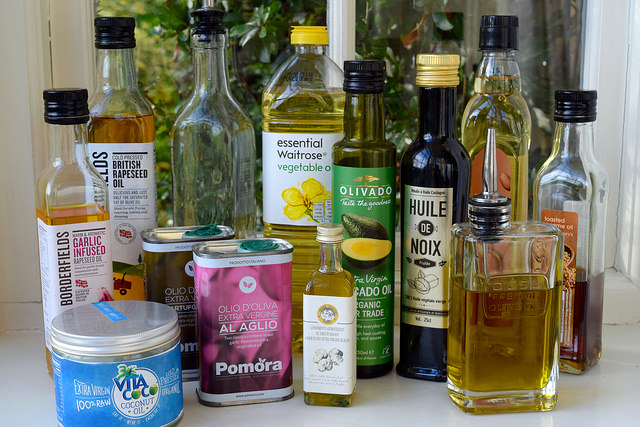
These are all of the oils that I use on a regular basis. Now, don’t get scared, out of everything you see here, you only really need two of them; the rest are just add ons for different effects and flavours. The main thing really is to find what suits you, and then find which brands you love. Once you’ve learnt the basics of which oils are mild and flavourless and you can use everywhere, which ones you can cook with to a high heat, and which flavours work with what, choosing your oil for the task at hand is really as easy as deciding if you fancy chicken or steak for dinner, and then if you want to flavour or marinate it, barbecue, grill of stew it.
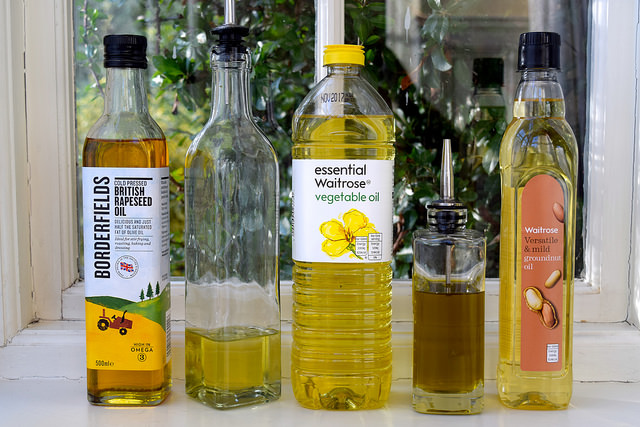
Let us start with the basics. The two oils here that are not marked and I keep in easy grab bottles is mild olive oil with I use for cooking, frying, and really anything where a cooking oil is called for and one has not been specified, and extra virgin olive oil. Now, you basic cooking oil of choice is up to what sort of cooking your usually do. I’ve just always used mild olive oil (you barely catch any flavour from it, but I find the little flavour it does have keeps from things tasting greasy), but something like a sunflower or vegetable oil is really cheap, and works for practically everything. You can use the two interchangeably, but I prefer vegetable, and use it in cakes, mostly, but to my Dad is it essential to fry Eggy Bread in. The other basically flavourless here is groundnut. Again, you can use it anywhere, but it is the oil of choice for so many Asian dishes, so I grab it for anything Chinese, Thai or Korean.
I’ve already mentioned the extra virgin olive oil. This has a lower smoking point that lighter oils (basically it burns at a lower temperature) but lots of Italian recipes do use it for frying. Just pay attention to the recipe. I tend to use it wherever I’m going to taste my oil such as for a drizzle or in a dressing, so I prefer grassier flavoured oils. At the moment I’m using a Greek number I was given at the Observer Food Monthly Awards, but usually the drizzler (the tall one was just a cheap one we’ve had for ages, but the beautiful one the extra virgin is in you can find here, with a matching balsamic bottle) is filled up with one of the beautiful extra virgin olive oils that come with the subscription Pomora were kind enough to hook me up with.
In the colder months, I like to use rapeseed oil as a base to cooking stews and soups, and to roast trays of vegetables in, or to smother over my roast chicken. I love the rich, warming flavour it adds to everything, as well as the brilliant yellow. All of my rapeseed needs are met by Borderfields at the moment, who sent me a massive great supply at the end of last year. Cooking with them for a while now, I must say that I am a fan!
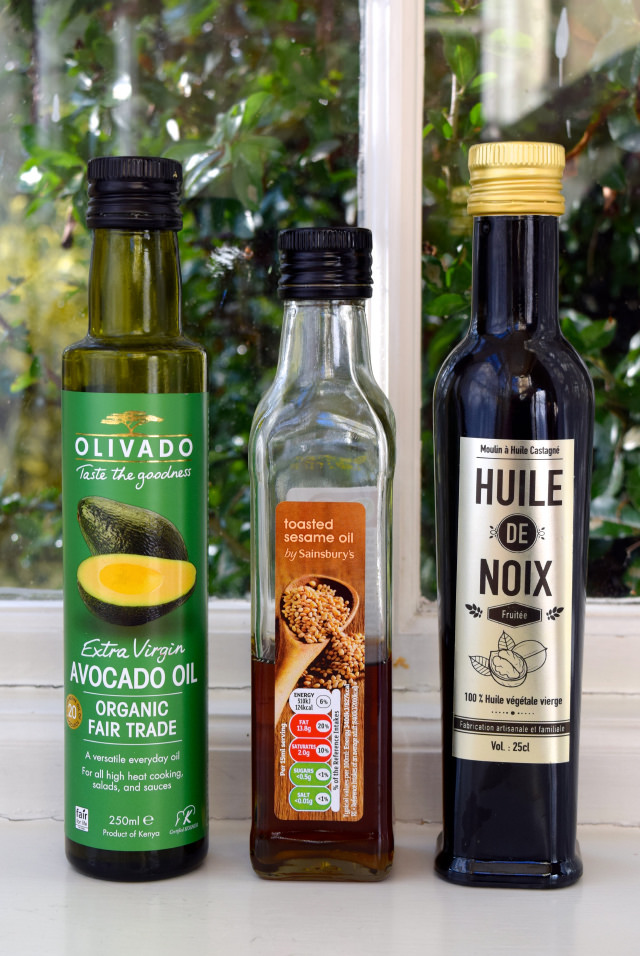
A trio of oils here that some people may not use at all, but some of you might get through like anything. I use extra virgin avocado oil for one thing and one thing only. I think it is a lesser oil in practically every single area except for when sautéing kale. I’ve tried every other oil, but avocado oil I think really does provide the best flavour to go with the brassica. Toasted sesame oil is big in Asian cooking. I use it sparingly in Chinese to add that takeaway flavour, but now I’m getting more and more into Korean food, I’m using an awful lot of it. It is best if you don’t think of it as an oil, but just another flavouring ingredient, as in most circumstances I would not fry in it alone.
Finally, a salad dressing oil. If you don’t buy salad dressings and prefer to make your own, any basic dressing is greatly enhanced by using a flavoured oil, a favourite of mine being walnut, which is also good in baking. My currently bottle is from Moulin a Huile Castagne in the Dordogne Valley, where I visited last year.
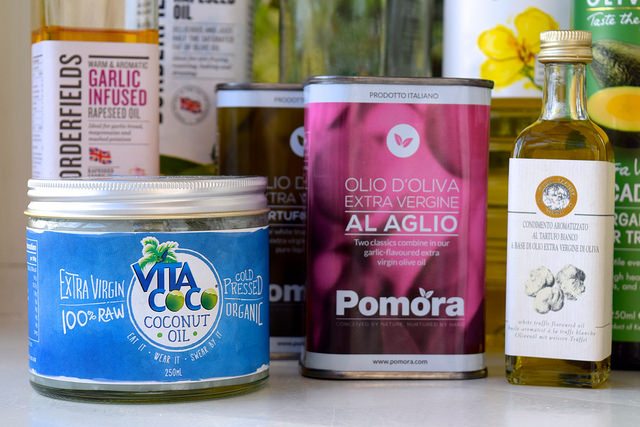
Finally, oils with a hell of a bit more flavour to them. I don’t like the taste of cheap coconut oil, and I always buy Vita Coco. Sometimes I use it in baking (I’m not a fan for most savoury applications), but the one reason why a jar is utterly essential to me at all times is because my all time favourite way to scramble eggs is in a generous spoonful of coconut oil. Not only does it give them a beautiful, slightly sweet, creamy flavour, but it makes them silky and rich without needing to add any additional cream or butter.
I’m a big fan of infused oils, my two essentials being garlic and white truffle. I have both rapeseed and extra virgin olive oils infused with garlic, which I use depending on the seasons. They are both great for roasting vegetables to give them a bit more flavour at any time of the year, and I brush bread with the garlic olive oil and barbecue it for a healthier garlic bread side in the summer months. In winter, the garlic rapeseed oil is my lazy helper; using it to fry off vegetables to start a soup or a stew means I don’t need to mess around with actual garlic! At the moment, I’ve got it right by the olive oils so I can grab it when I’m cooking and experimenting.
I know lots of food people look down on truffle oil, but I personally love it to add a bit of perfume to any dish. I usually keep a small bottle in the cupboard for dressings and pastas as a little goes a long way, but currently I’m also loving the extra virgin version that came in a recent Pomora delivery to make the bottle of truffle vinaigrette which is pretty much a permanent resident in the fridge door.
So, a recap: all you really need is a light oil for frying (choose one to suit what sort of things you like to cook and your budget), and a nicer quality one that you like the taste of by itself for dressings and drizzles. Any other oils can be added to your kitchen as and when you find you like them and you use them. Oils tend to have relatively short shelf lives, so when you’re trying something new, buy the smallest size possible. You can then re-purchase when you’ve found what you like, and choose which size bottle you think you need depending on how quickly you’ve used it all up!


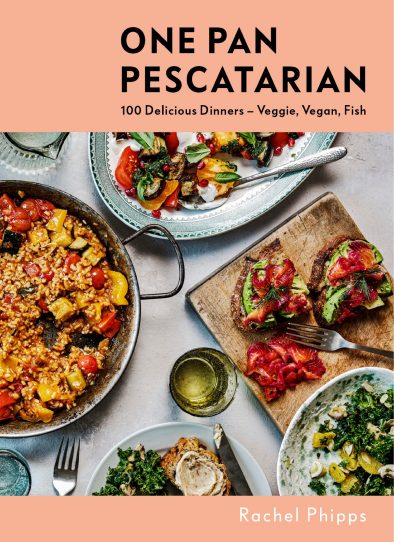
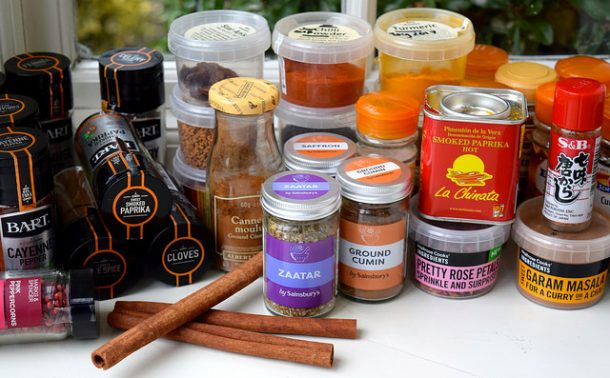
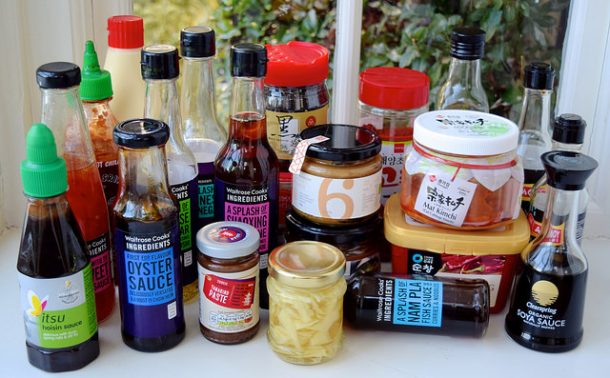
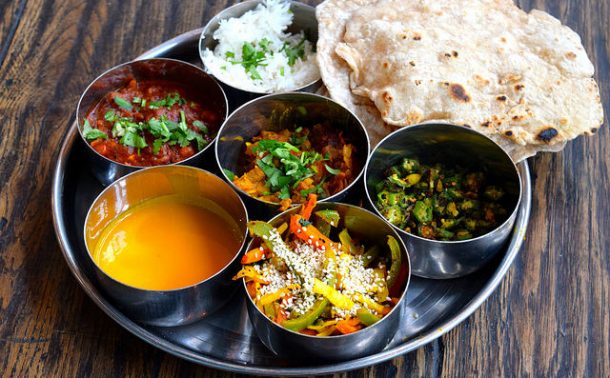
Discussion